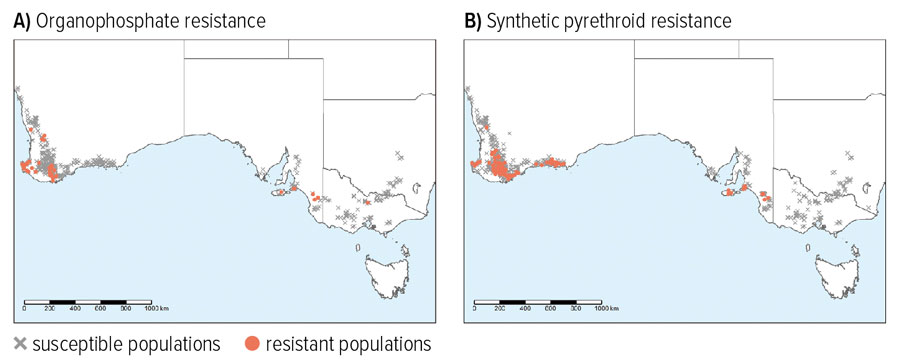Key points
- The rate of insecticide resistance to several chemicals is rising in redlegged earth mites (RLEM)
- Management of RLEM should follow the recommendations outlined in the national resistance management strategy and the recently released Redlegged Earth Mite Best Management Practice Guide – Southern (2020)
Redlegged earth mite (Halotydeus destructor – RLEM), a major pest of pastures and grain crops, is ubiquitous across Australia’s southern cropping region. These mites cause significant damage during seedling establishment – when the crop is most vulnerable – resulting in the potential for considerable economic losses. Insecticide resistance to synthetic pyrethroids in RLEM in Australia was first detected in WA in 2006, followed by organophosphate resistance in 2014. Since these discoveries, resistance to both chemical groups has been found to be common across large areas of WA and has recently been discovered in south-eastern Australia.
In response to these resistance issues, a national resistance management strategy for RLEM was developed by the National Insecticide Resistance Management (NIRM) working group. The strategy recommends a range of cultural and chemical rotation methods to minimise selection for resistance while still effectively controlling RLEM. In addition, research through a GRDC investment was undertaken to find out how resistance in RLEM evolves and how widespread it is, and to improve resistance management strategies for this mite.
From 2016 to 2020, a multi-faceted GRDC research investment was undertaken by the University of Melbourne, the WA Department of Primary Industries and Regional Development, CSIRO and cesar. Key research components included extensive field surveillance of resistance across the known RLEM distribution, establishment of new methodologies to test for resistance, generation of baseline sensitivity data for neonicotinoids and new chemistries, as well as studies to determine whether there are any fitness penalties in RLEM that evolve resistance.
Figure 1: The known distribution of organophosphate and synthetic pyrethroid resistance in redlegged earth mites across Australia as of 2019. Red dots indicate resistant populations and grey ‘x’s’ indicate susceptible populations.

Source: Dr James Maino, cesar
Research lessons?
RLEM resistance to both synthetic pyrethroids and organophosphates was found to be spreading across large areas of WA and to be present in several areas of SA and Victoria (see Figure 1). Using genomic techniques, the project team demonstrated resistance had evolved independently at multiple locations. This shows the importance of what individual growers do on their farm when it comes to RLEM management.
Further, the project showed that the frequency of synthetic pyrethroid resistance can increase rapidly in RLEM populations when exposed to these chemicals in the field, but no such increase was seen in the case of organophosphate resistance. This leaves the door open to control options using organophosphates, although there is potential for RLEM to evolve further resistance.
Researchers also found that diafenthiuron (for example Pegasus®), a recently registered RLEM insecticide for use in canola, was effective in controlling dual-resistant RLEM.
Insecticide resistance is based on changes that occur at the molecular level. The molecular mechanisms of organophosphate resistance in RLEM were found to be complex and are still not fully understood. It appears that multiple resistance mutations are contributing to organophosphate resistance and that these may vary in importance across the country.
Pre-emptive research was undertaken to develop robust and sensitive bioassay methodologies to test for shifts in sensitivity to neonicotinoids and diafenthiuron. This work also includes the establishment of baseline sensitivity data for RLEM, which will be important to industry for early detection of insecticide resistance to these chemicals.
Fortunately, there does not appear to be any field resistance to neonicotinoid seed treatments in Australian RLEM.
Managing resistance
Management of RLEM should follow the recommendations outlined in the national resistance management strategy and the recently released Redlegged Earth Mite Best Management Practice Guide – Southern. This will help reduce the risk of further resistance evolution. Recommendations include avoiding unnecessary spraying, rotating between chemical groups, strategic spraying (for example, along fencelines) and using biological and cultural control strategies.
More information: Redlegged Earth Mite Best Management Practice Guide – Southern, Resistance Management Strategy for the Redlegged Earth Mite in Australian Grains and Pastures; Dr James Maino, cesar, 03 9349 4723, jmaino@cesaraustralia.com

























































